2016 New York Auto Show Winners & Losers
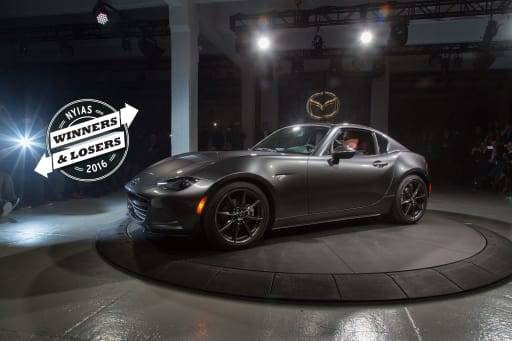
CARS.COM — Life is fast-paced in New York, and the 2016 New York International Auto Show had a downright frenetic pace. With more than 30 cars revealed to the automotive press this week, there was plenty to take in.
More 2016 New York Auto Show Coverage
Editors Aaron Bragman, Joe Bruzek, Mike Hanley and Brian Wong dig into the debuts to discuss which cars stood out — for better or worse.
2017 Acura MDX
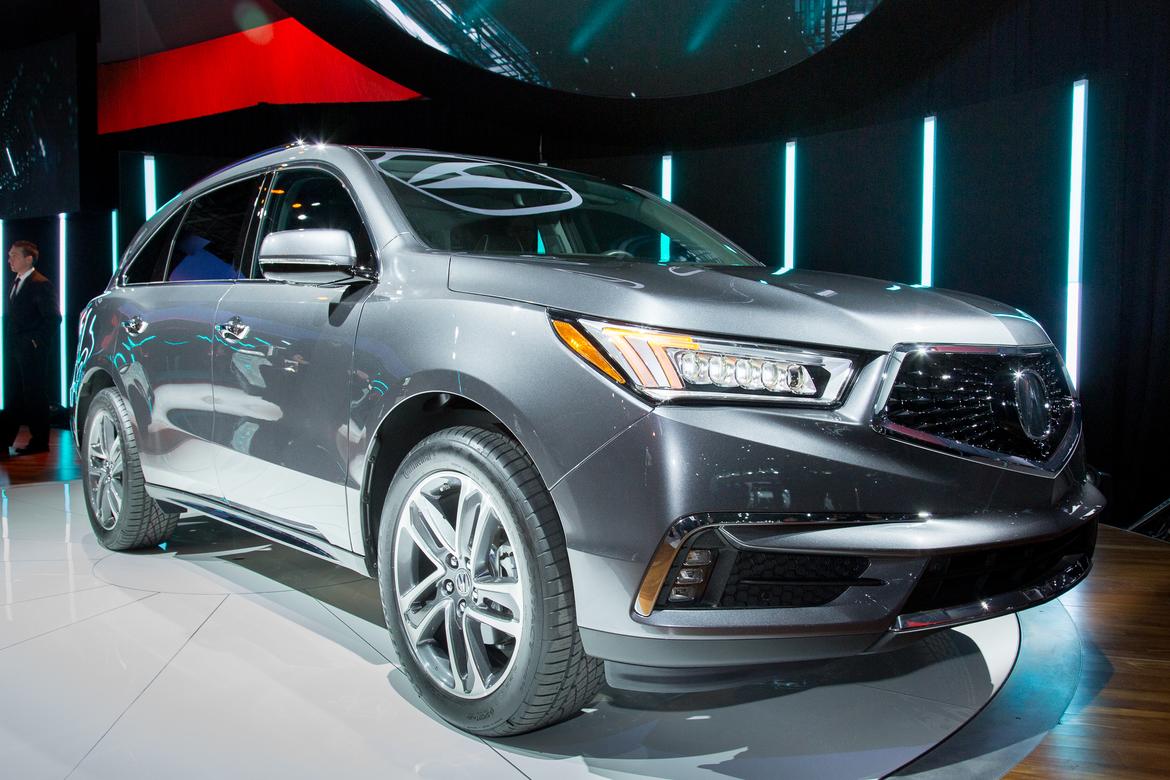
2017 Acura MDX
Cars.com photo by Evan Sears
Aaron Bragman: Loser
I just can’t get excited about a mild nose job and the addition of a hybrid. The seats look a little nicer than the current version, but the same “nice Honda” dash, gauges and split-level multimedia screen remain. The new face is a little less ugly, but what’s the compelling reason for choosing this over a Lexus RX?
Brian Wong: Loser
Unlike Bragman, I can get excited about some automotive rhinoplasty, but when the end product is so uninspired, I find myself flat lining as well. Inside, there are things that I like — I counted seven USB ports scattered across the three rows of seats, and interior materials quality is good. But the split-level screen looks pixelated (read: old), and the styling is still “meh.” There’s just not enough there to bring the MDX up to the winners’ circle.
Joe Bruzek: Loser
I think Acura’s new styling direction is a good step for the brand, but I’m not so sure a mild update to an existing SUV was the best way to introduce the new look, especially considering how recently the MDX was redesigned (2014). The nose looks tacked-on, possibly because we’re so used to seeing the rest of the MDX with styling that’s relatively unchanged in this update.
Mike Hanley: Loser
Few brands have faced as much withering criticism for front-end styling as Acura has in recent years. I’ve grown used to the most recent version of the Acura shield, and the new design on the MDX doesn’t seem like an improvement. It’s just a different kind of shield, and I agree with Wong’s assessment that it looks uninspired.
2017 Buick Encore
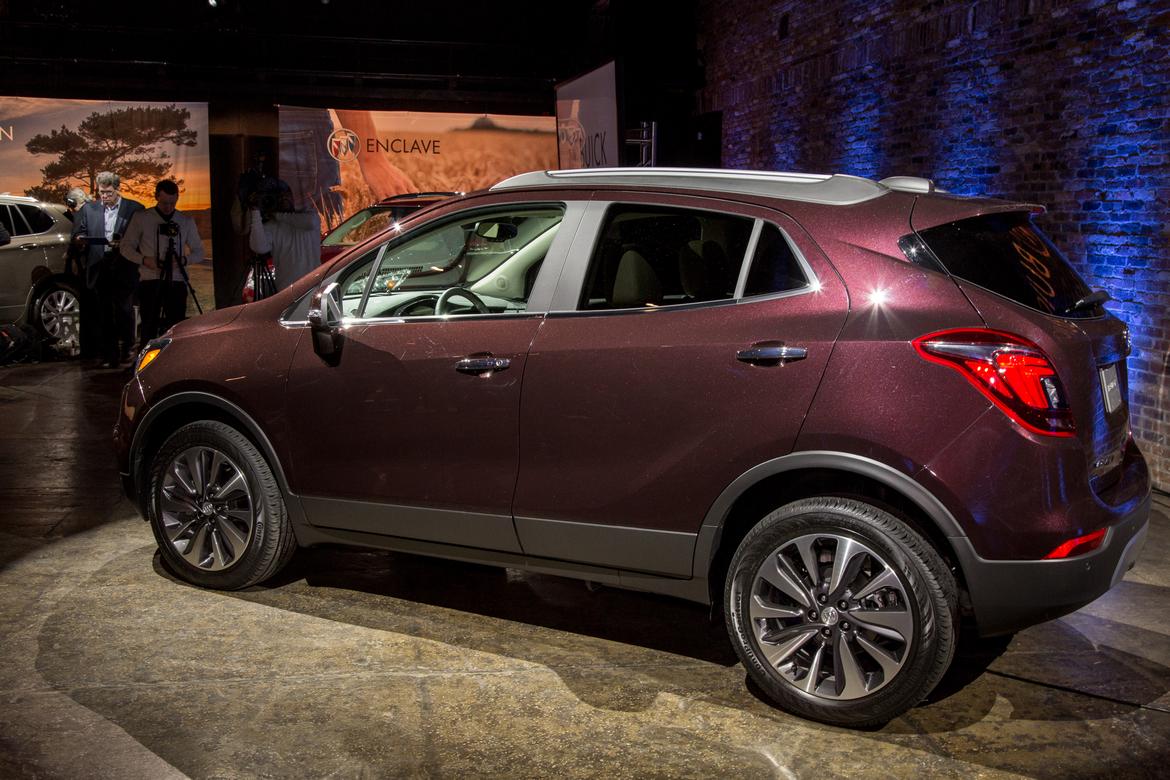
2017 Buick Encore
Cars.com photo by Angela Conners
AB: Winner
Buick took a lesson from Pontiac (back when Pontiac was still around) and dropped the ugly gray plastic cladding from the Encore, and what a difference it makes. Body-colored bumpers and a much nicer interior finally make this thing feel as premium as Buick keeps wanting us to believe it is.
BW: Loser
It does look better, I’ll give you that, but it would have been hard to make it worse. Even with the addition of better materials inside there are plenty of compromises that make the Encore tough to live with. There’s still no armrest for the front passenger seat, rear legroom is tight and the rear seats don’t fold without a strange three-step process that ends with the seat belt buckles getting stuck under the bottom seat cushions.
JB: Winner
The Encore always has been a personal favorite. Adding cues from Buick’s Avenir and Avista concepts translates surprisingly well to the tiny Buick. While its interior may have a new look, the materials and textures don’t appear or feel significantly higher-quality than the outgoing model. The additional standard multimedia equipment is a solid addition, however.
MH: Winner
I’ve never been a fan of the Encore’s styling, and while it’s still a stubby-looking subcompact SUV, Buick’s new exterior design language works quite well on it. In addition, the center control panel has been simplified; the prior model’s cluster of dashboard buttons is thankfully gone.
Genesis New York Concept
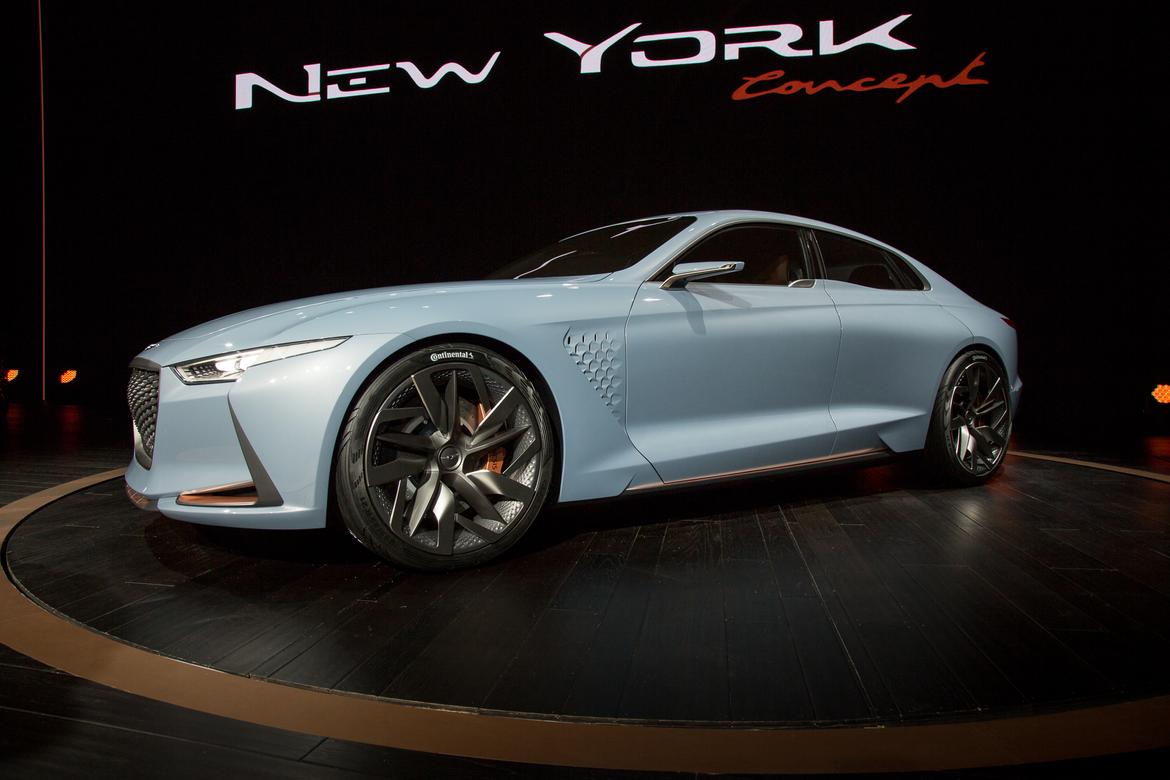
Genesis New York Concept
Cars.com photo by Angela Conners
AB: Winner
This thing is gorgeous, with a style that finally separates it from other Asian-brand luxury vehicles. The roofline and rear treatment looks like it’s right off the Mercedes-AMG GT coupe, while the interior is modern and unique, not derivative at all. It’s obvious to me now where all of Hyundai’s former styling bravado has ended up.
BW: Winner
We seem to be in the midst of a fastback renaissance and I love it. The small gill-like openings behind the front wheels would usually annoy me as a bit of concept-car largesse, but in this case I like them. They match the grille and the openings found on top of the hood as well. Inside, the 21-inch curved screen is gorgeous and makes sense for future applications — there’s no reason to split screens anymore, not with this technology rapidly improving. If Genesis actually succeeds in shaking up the luxury segment, we all win.
JB: Winner
The budding Genesis luxury brand immediately gets bonus points for not calling this a four-door coupe in press literature. The Genesis New York Concept may have a fastback profile similar to sedans such as the Audi A7 or Mercedes-Benz CLS-Class, but the concept is otherwise unique with its own curvy character accentuated by the Ceramic Blue exterior color. I don’t think this car would have popped the way it does if it was painted silver.
MH: Winner
You can see inspiration from other luxury brands in the New York Concept’s design, like the gaping Audi-style grille and slim Mercedes-like taillights, but there are enough unique design cues, like the subtle belt line curve where the front and rear doors meet, to give this concept its own identity — and an identity for Hyundai’s fledgling luxury brand.
Lincoln Navigator Concept
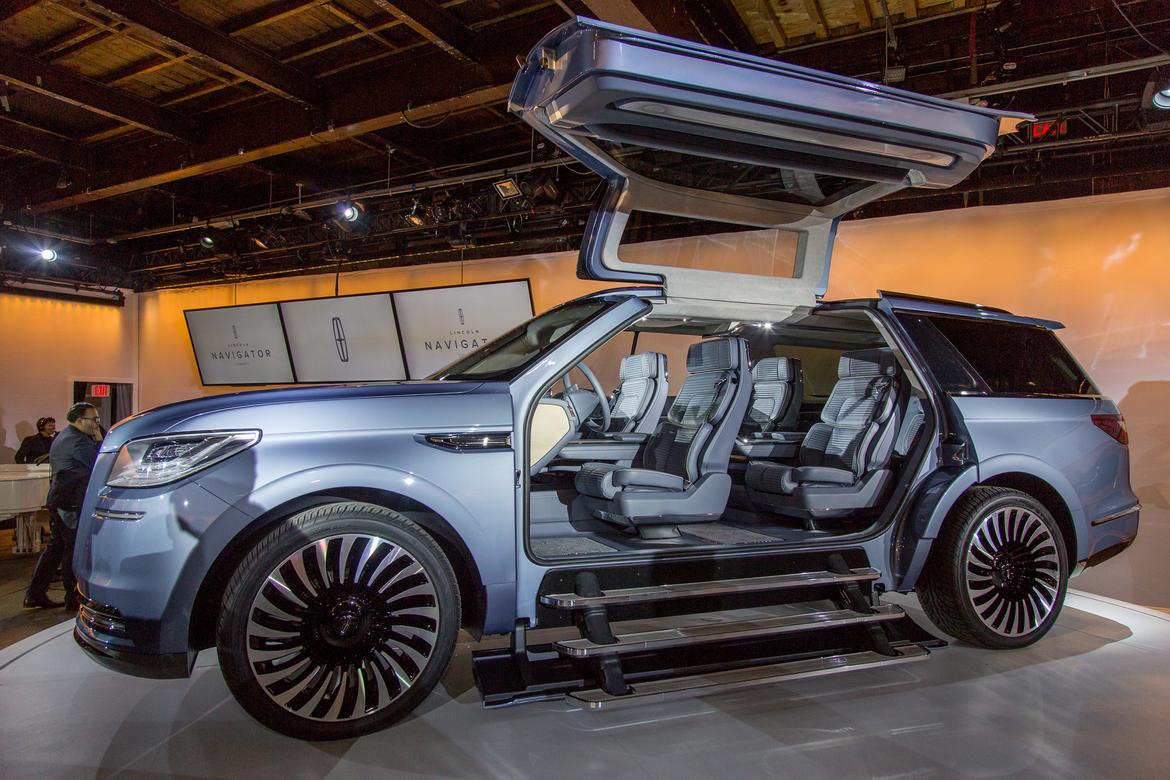
Lincoln Navigator Concept
Cars.com photo by Angela Conners
AB: Winner
This thing is exactly what the next Navigator needs to be to keep the die-hard Lincoln faithful and maybe even bring in some new buyers who have been thinking about a Cadillac Escalade or a Land Rover Range Rover. Impossible gull-wing doors aside, the clean interior, midcentury modern seats and Range Rover XL exterior are the best expression yet of Lincoln’s new strategy.
BW: Loser
If your theme is “quiet luxury,” it doesn’t make sense to put the least practical doors on your concept — reality based or not. Doors aside, the potential changes this signals for the Navigator are positive; the full-size SUV is in dire need of a styling update so if this is a sign that Lincoln is ready to give it a redesign, I’m onboard. But it’s still a loser to me because with those doors up it doesn’t look futuristic, it looks goofy.
JB: Winner
Lincoln’s use of simplified, elegant center controls instead of the current Navigator’s layered stack of buttons is a step in the right direction. The massive gull-wing doors keep the profile clean, though obviously a novelty, but the multiple-tiered baby steps are something I’d welcome when ordering an Uber XL after a long night on the town.
MH: Loser
You don’t have to look hard at the auto industry to see that brands like to borrow design ideas, but few brands have been as, shall we say, enthusiastic as Lincoln of late, first with the Continental and now with the Navigator Concept. If luxury SUV buyers want a Range Rover, they’re going to get a Range Rover, not a Lincoln. I guess this is the result of a luxury brand that’s been trying to find an identity for years.
2017 Hyundai Ioniq
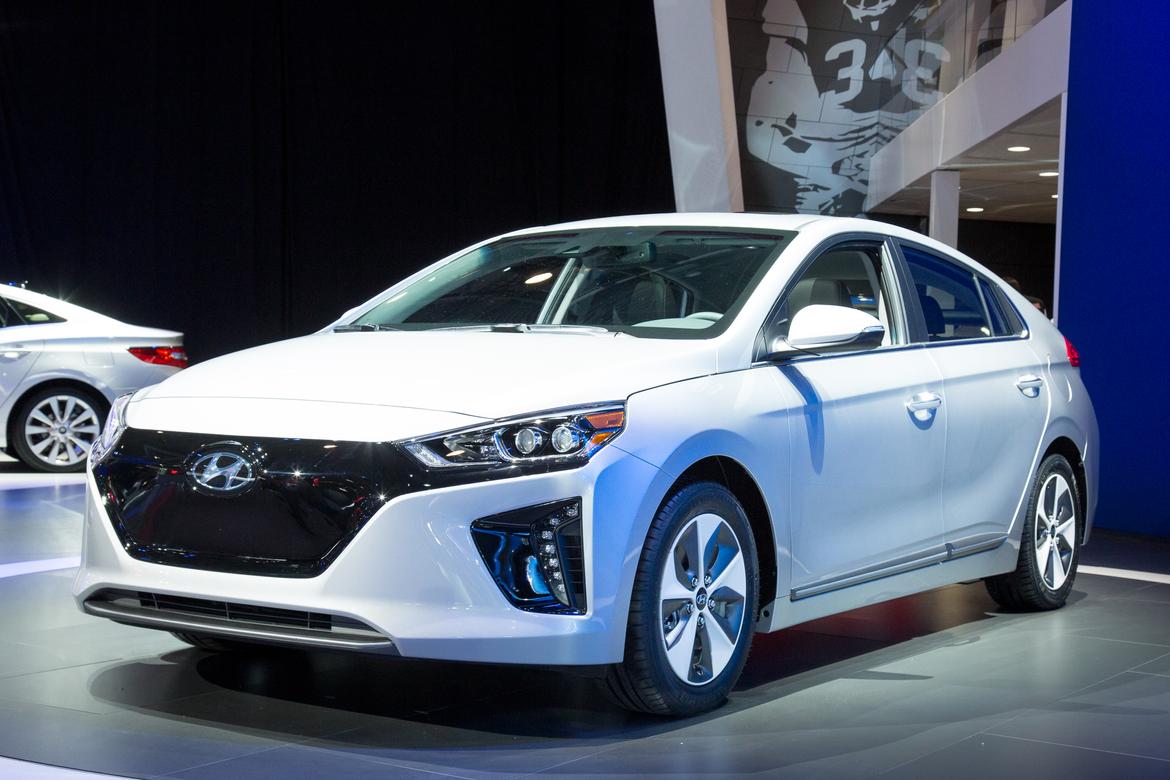
2017 Hyundai Ioniq
Cars.com photo by Evan Sears
AB: Loser
Hybrids already have a reputation for being less than exciting, so the wisdom behind containing your latest, greatest technology in a plain-brown wrapper eludes me. Boring to look at, unpleasant to sit in thanks to cheapo materials, the Ioniq had better get unbelievable fuel economy or come with a free puppy if Hyundai wants to grab Toyota Prius buyers.
BW: Loser
There isn’t anything wrong with the Ioniq, which seems to have been hatched in a lab that specializes in the inoffensive. Sit inside and it feels like any other compact car; see it cruising down the street and it blends in like it’s wearing camouflage, which may be too subtle for eco-friendly car shoppers. The announced electric ranges for both the plug-in and electric versions are also a step behind the latest offerings from Chevrolet. Compared to the new 2017 Toyota Prius Prime, which also debuted at the New York auto show, the Ioniq is second fiddle. Or second, third and fourth fiddle, that is.
JB: Loser
Official EPA ratings will tell where the Ioniq falls in the grand scheme of hybrid, plug-in hybrid and electric vehicle performance; Hyundai only has estimates so far. The Ioniq’s similar interior and cargo usability between all three models is a nice perk considering variations in battery size between electrified variations of the same model often hurts cargo or passenger room. The cars are all very sterile, so they’ll need a win in the efficiency or value department to stand out when you have a new Toyota Prius OptimusPrime with an 11.6-inch touch-screen and chiseled good looks.
MH: Winner
Compared with the redesigned Toyota Prius’ wild styling, Hyundai’s new Ioniq family indeed looks conventional inside and out. But it’s a clean, attractive design that works well with the car’s four-door hatchback profile. With the choice of three alternative-fuel drivetrains, including an all-electric version, eco-conscious buyers shouldn’t have trouble finding an Ioniq that’s right for them.
2017 Kia Cadenza
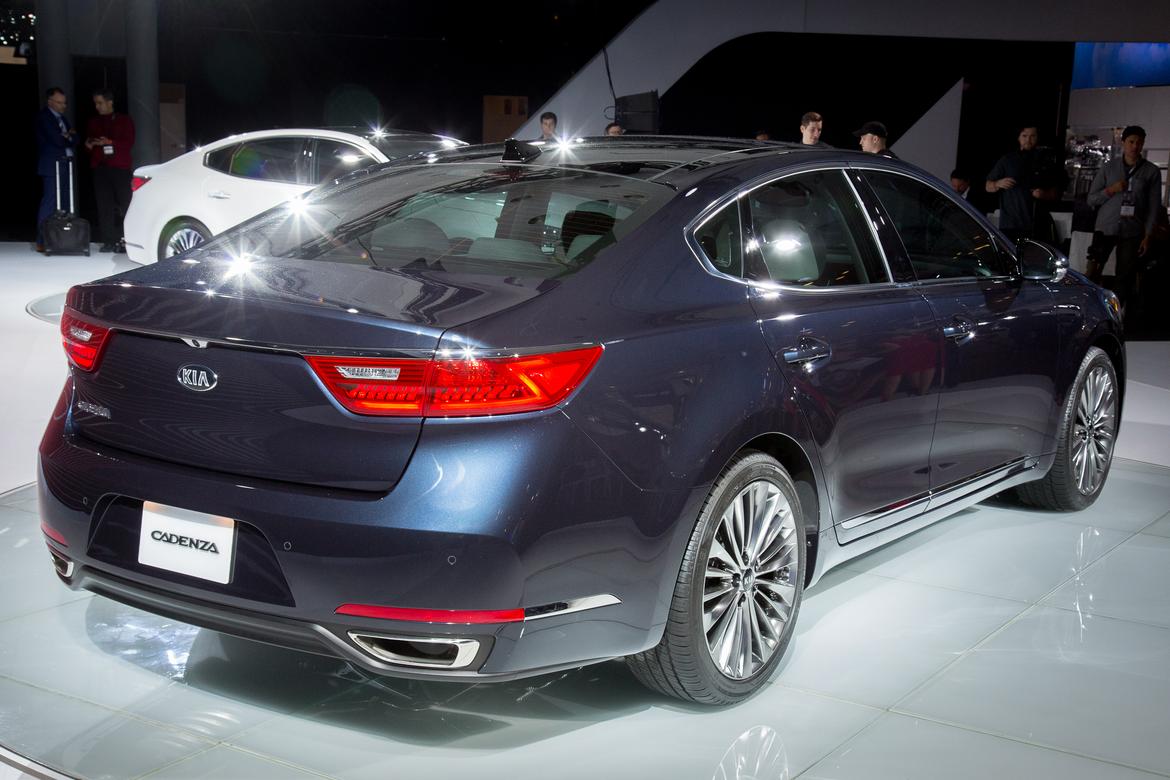
2017 Kia Cadenza
Cars.com photo by Evan Sears
AB: Loser
I’m not sure what the point of the Cadenza is, given that Kia already has a large, premium rear-wheel-drive vehicle — the K900 — that both looks and drives better than the Cadenza. That the entire car is nearly the spitting image of the Volvo S90 doesn’t help, either (all it’s missing is a diagonal stripe in the grille).
BW: Winner
As a man who loves a sale, the Cadenza appeals to me as a car that offers a luxury-type experience at a non-luxury price. The Cadenza is sneaky good on the inside (sitting in the backseat actually brought to mind the Cadillac CT6) with added standard equipment, and I am a fan of the new styling, S90 similarities or not.
JB: Loser
The Cadenza’s changes for 2017 are more than skin deep, but what we see on the surface is competing against redesigned full-size premium sedans such as the Nissan Maxima and Buick LaCrosse, both of which took substantial leaps in offering more premium interiors. The Cadenza’s is just a modest improvement.
MH: Loser
The grille’s razor-blade styling is a little much; otherwise the 2017 Cadenza is a handsome-looking large sedan. But like the brand’s recently updated Optima midsize sedan, the Cadenza’s overall design hews close to the look established by its predecessor, and that commonality prevented it from standing out on the show floor.
2017 Mazda MX-5 Miata RF
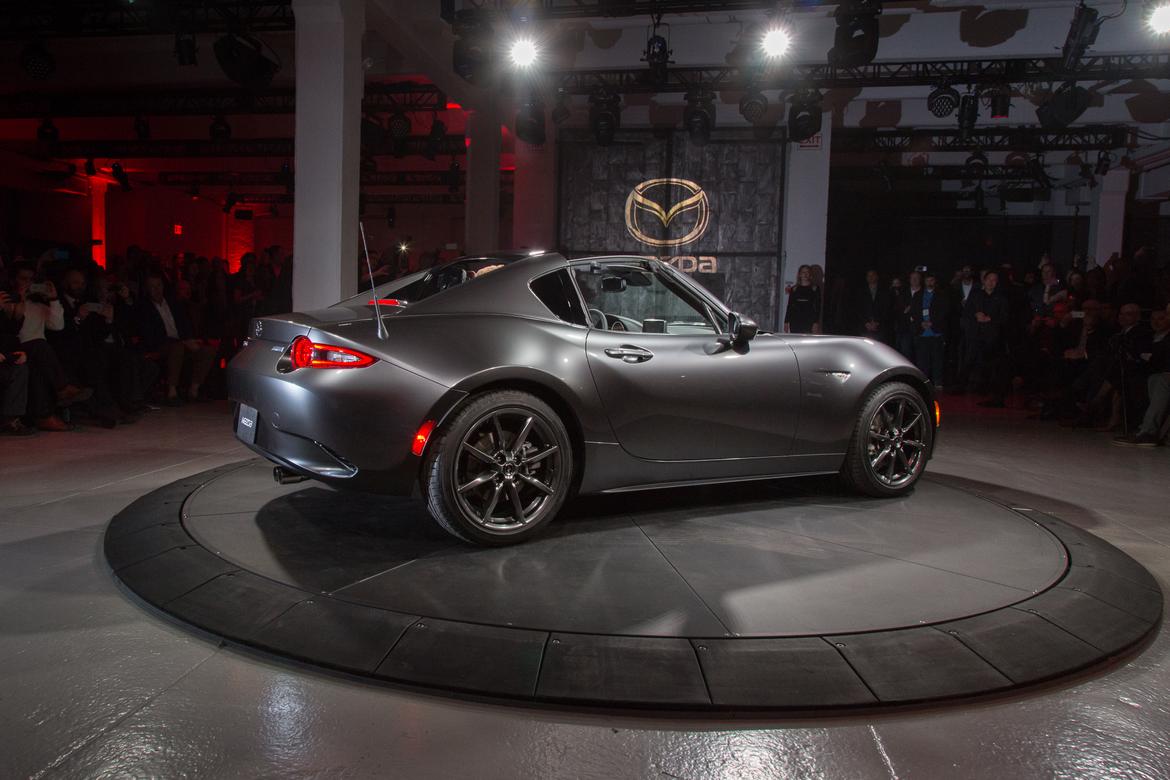
2017 Mazda MX-5 Miata RF
Cars.com photo by Angela Conners
AB: Winner
I’m not sure how Mazda did it, but it has managed to make the already pretty MX-5 Miata even more attractive. I don’t mind that it’s not a full convertible like the old power retractable hardtop version, as the MX-5 Miata RF has flying buttresses that look fantastic — it would be a shame to hide them away.
BW: Winner
Full disclosure: I drove a second-generation MX-5 Miata with a manual for two years in Los Angeles traffic and still loved it. Now I’m in love again. When those doors opened at the Mazda event and the Miata MX-5 RF rolled onto the stage, I didn’t realize my mouth was open until a few minutes later. It is staggeringly good looking (top up or down). This car takes best in show for me.
JB: Winner
The MX-5 Miata RF is practically an MX-5 fastback in appearance, and I dig it. I just wish the coupe look could have been incorporated while delivering a full-blown convertible experience, which we know works well in the regular MX-5. My worries are wind buffeting and an unpleasant open-air experience with the weird kind-of Targa top and open rear glass; though I’m sure Mazda spent plenty of time developing the roof’s aero shape.
MH: Winner
The MX-5 Miata RF’s power-retractable top does a complicated dance when it’s lowered or raised, just like the roof of the Porsche 911 Targa. It makes me a little concerned about long-term reliability, but not enough to douse my enthusiasm for the car’s new coupelike styling, which looks great.
2017 Mercedes-Benz GLC Coupe

2017 Mercedes-Benz GLC Coupe
Cars.com photo by Evan Sears
AB: Loser
This thing has only one purpose in life: to boost Mercedes-Benz’s market share by offering up even more variants of vehicles, going toe-to-toe with BMW in every crazy invented segment. The “luxury SUV four-door coupe” was a dumb idea the first time it was suggested, and it continues to be a dumb idea in what has to now be the fourth size segment in which it has appeared.
BW: Loser
Despite the slope of its roofline, rear legroom and headroom are pretty good. Rear visibility, however, is terrible and nearly Chevy Camaro-esque. And as Bragman said, its mere existence is a questionable thing; it’s hard to call the GLC Coupe a winner when I don’t see who would ever buy one. Even among other Mercedes-Benz models, there are better options for both people carrying and style. If you build it … they may not come.
JB: Winner
The GLC “stop-calling-it-a-coupe” is one of the more passable executions of this style thanks to a perfectly comfortable backseat and the large styling differentiation between the regular GLC SUV and this sloped-roof model.
MH: Loser
The GLC Coupe looks sleeker than Mercedes’ larger GLE Coupe, but the appeal of the growing coupelike SUV segment is lost on me. Without the utility of an SUV or the performance of a true coupe, the GLC Coupe and models like it compromise on many things and excel at few.
2017 Nissan GT-R

2017 Nissan GT-R
Cars.com photo by Evan Sears
AB: Winner
This was a tough decision, as I am underwhelmed by GT-R’s update. The styling is barely different, front and rear, and the interior updates, while welcome, are similarly unimpressive. The only saving grace here is that the GT-R was already a fantastic, attractive, approachable supercar that’s able to do things for its driver that are amazing — and the new one has improved on that approachability.
BW: Winner
Though it’s not a huge overhaul, the updates work to make the GT-R easier to live with, without reducing its viability as a track-day weapon. Inside the materials have taken a leap, and Nissan says that the transmission is smoother, which will pay dividends in everyday driving. I agree with Bragman — the GT-R’s pedigree factored into my decision. But it also seems unfair to punish something for starting ahead of the pack.
JB: Winner
The GT-R’s interior certainly hasn’t kept up with its astronomical price increase over the years from 2009’s $77,840 starting price to 2016’s $103,365. The new GT-R’s high-quality leather interior and fresh color combinations are far more appropriate for a $100,000-plus sports car.
MH: Winner
While enthusiasts may be disappointed Nissan didn’t debut a fully redesigned GT-R, the automaker addressed the most glaring shortcoming of its supercar by giving it a new interior. The design takes styling cues from Nissan’s newest cars, and the changes give the GT-R a cabin befitting its six-figure price tag.
2017 Subaru Impreza
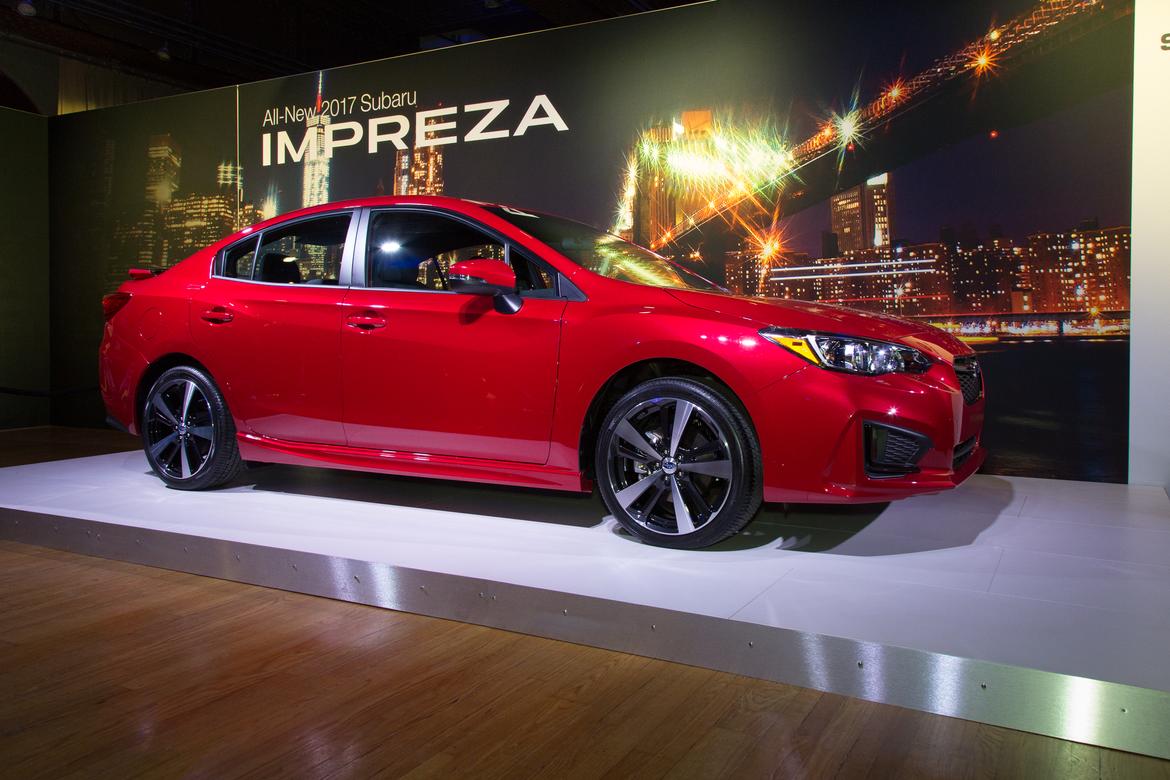
2017 Subaru Impreza
Cars.com photo by Angela Conners
AB: Winner
No, it doesn’t look much like the Impreza Concept we saw at the 2015 Los Angeles Auto Show, but then did anyone really expect it to? Subaru gave it a freshening but really improved the areas that had the most difficulty — interior material quality and the multimedia system. This is a solid update.
BW: Winner
The new Impreza looks better than the previous model, but in my opinion the one thing holding Subaru back has been its interiors. However, the Impreza finally has a good one with better materials, more comfortable seats and easier-to-use buttons for the multimedia system. Add that to Subaru’s solid safety ratings, standard all-wheel drive and resale value benefits, and what you end up with is a compact car that now checks all the boxes.
JB: Winner
More than just the stylish sedan and hatchback we saw in New York, I’m excited at the prospect of the next-generation WRX given the new Impreza’s sleek appearance, quality interior and promise of chassis improvements. The Impreza is solid inside and out, so let’s get a jump on the next WRX, please?
MH: Loser
The new Impreza’s styling is less blocky than before, and interior quality is notably improved, but it was hard to get excited about either the sedan or four-door hatchback at the Subaru stand. With so many other interesting debuts, this one underwhelmed.
2017 Toyota Prius Prime

2017 Toyota Prius Prime
Cars.com photo by Angela Conners
AB: Loser
In this day and age, when plug-in hybrids can achieve more than 50 miles of range without much effort, the ability to go 22 miles on a charge before switching to gas no longer is admirable. The styling changes to the Prius Prime are surprising and actually work better than the standard Prius’ looks, but right now the Chevrolet Volt is the car to beat in this segment, and it doesn’t look like the Prime can do that.
BW: Winner
I agree with Bragman: 22 miles of electric range is not something to brag about, man. However, the make or break element for me with the Prius Prime is its centerpiece: the 11.6-inch, vertically oriented touch-screen. I found its performance to be nearly optimal; the screen is responsive and the menu design is intuitive (it has to be, with no Android Auto or Apple CarPlay on tap). There was a slight delay to zoom movements on the map; otherwise the system didn’t lag at all. Hopefully this is the first sign that Toyota is ready to put more really big screens into its really big team of vehicles.
JB: Winner
There are still a number of unknowns regarding the AmazonPrime’s fuel economy without official EPA ratings. The estimated 22-mile electric-only range isn’t a deal-breaker in my book, however, considering hybrid fuel economy when electric-only juice runs out is being targeted for 50-plus mpg (the Volt is 42 mpg combined) and the total electric-and-gasoline range is predicted in the 600-mile range.
MH: Winner
The Prius Prime trades some of the regular Prius’ avant-garde styling cues for more traditional horizontal headlights and taillights, and it’s a good look for this alternative-fuel hatchback. The large, vertically oriented touch-screen recalls the one in the Tesla Model S, and it responds quickly to menu selections and has an intuitive interface. The changes make the Prius, a car that’s now appealing for reasons other than just fuel economy, even more attractive.
Featured stories




